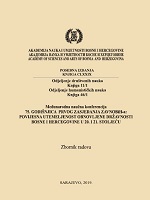ZAVNOS I ZAVNOBIH U KOMUNISTIČKOJ KONCEPCIJI STVARANJA FEDERATIVNE JUGOSLAVIJE
ZAVNOS AND ZAVNOBIH IN THE COMMUNIST CONCEPTIONS OF CREATING FEDERAL YUGOSLAVIA
Author(s): Azem Kožar
Subject(s): Political history, Nationalism Studies, WW II and following years (1940 - 1949), History of Communism
Published by: Akademija Nauka i Umjetnosti Bosne i Hercegovine
Keywords: CPY; National Liberation Movement; federative Yugoslavia; Bosnia and Herzegovina; Antifascist Councils; Bosnia and Herzegovina; Sandžak; national question; Partisan autonomy;
Summary/Abstract: The Partisan War Autonomy of Sandzak, as a multinational province inhabited by Serbs, Montenegrins and Muslims, functioned between the First and Second Sessions of the National Anti-Fascist Council of Sandzak (ZAVNOS), that is, from 20 November 1943 to March 29, 1945. It made a significant contribution to the faster development of the anti-fascist National Liberation Movement (NOP) in this area. It has contributed to the suppression of inter-ethnic conflicts, the popularization of the anti-fascist movement, the establishment and functioning of organs of the public authorities, the mobilization of people in the partisan units, etc. It was created as part of the realization of the party conception of the Yugoslav war federalism, which resulted in the establishment of five national states (Serbia, Croatia, Slovenia, Montenegro, Macedonia) and the sixth Bosnia and Herzegovina as multinational states (Serbs, Muslims and Croats), and in the status of federal units the new Yugoslavia. The reasons for the liquidation of Sandzak’s war autonomy at the end of the war have not been adequately investigated historiographically. What is the reason for this is indicated in the official positions of the NOP institutions, called political, economic and ethnic reasons, the need to prevent the “fragmentation” of Serbia and Montenegro, and that Muslims can exercise their national rights freely within them ZAVNOS has never asked for the special position of Sandzak, etc., apparently they were not, nor should they have been, arguments in favor of the abolition of autonomy and the division of Sandzak. These are publicly silent invisible reasons. It is about changing the attitude towards the ethnicity of Muslims in the leadership of the NOP, which they did not consider as a nation, but an ethnic group (a nation in formation), which as such can not be a constituent element of the federation. It turned out that at the time of the establishment of the ZAVNOS and ZAVNOBiH, in which the Muslims were one of the three nations, only the declarative acceptance of the ethnicity of the Muslims was present. The essential consequence of changing this relationship is not only the abolition of the autonomy of Sandzak, but also its division by the border line from 1913 between Montenegro and Serbia. The fact that Bosnia and Herzegovina retained the status of a federal unit, despite denying the nationality of Muslims as one of its three peoples, is conditioned by numerous other irrefutable arguments. It was thought that Muslims would assimilate into Serbs, Croats and Montenegrins, and thus disappear as a nation, and these efforts are recognizable in years, even decades after the war, which, however, did not happen. By acknowledging the ethnicity of the Muslims twenty years later, the KPJ practically acknowledged all its misconceptions and inconsistencies on the proper solution of the national question. However, the collapsed war autonomy of Sandzak and the repatriation of Muslims to the national minority level had long and varied negative consequences, not only for Muslims, but also for Sandzak and Bosnia and Herzegovina, as well as for socialist Yugoslavia as a whole.
- Page Range: 151-179
- Page Count: 29
- Publication Year: 2019
- Language: Bosnian
- Content File-PDF

